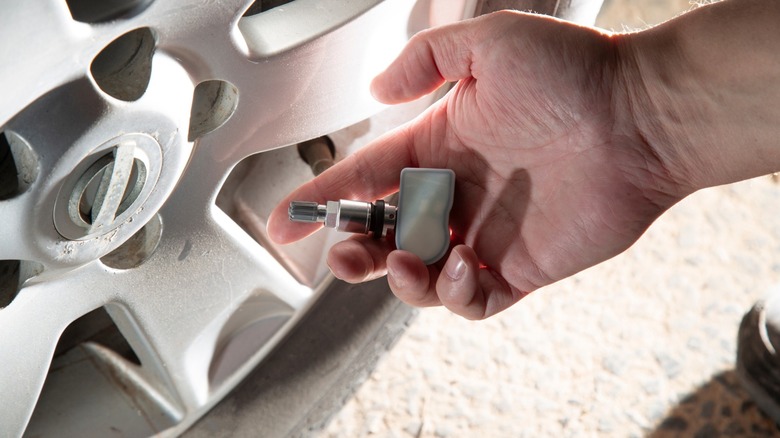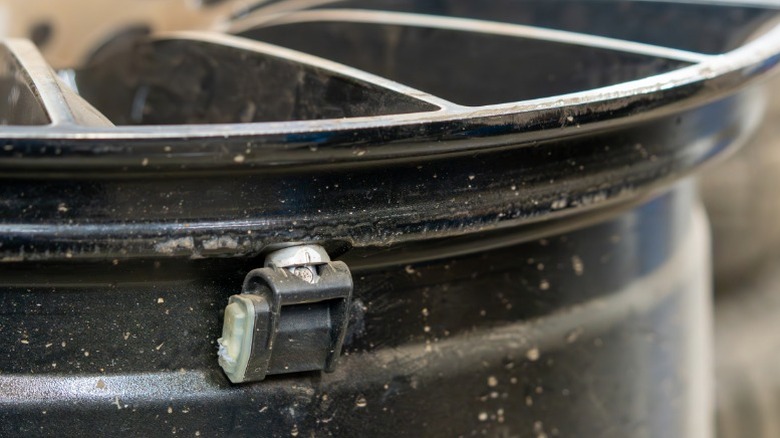Yes, You Can Replace Your Tires' TPMS Sensor Yourself (But Here's Why We Wouldn't Risk It)
Modern cars can do a lot of impressive stuff. The onboard diagnostic (OBD) system can tell us when there's a vehicle malfunction by activating the check engine light, while advanced car safety features can help keep you and your passengers secure when cruising down the highway. Most newer vehicles can even tell you when your tire pressure is too low (and, depending on the car, which individual tire or tires need a top off), thanks to the tire pressure monitoring system (TPMS).
Most modern cars have either an indirect or direct TPMS. Indirect tire pressure monitoring systems generally rely on the anti-lock braking (ABS) speed sensors, which are usually installed on the wheel hubs, to monitor the speed of the wheel's rotation as you drive. The system compares that data to the speed at which your wheels should rotate when the tires are properly inflated and will alert you if one or more tires are filled incorrectly. Direct tire pressure monitoring systems, on the other hand, rely on TPMS sensors to monitor the tires' air pressure and temperature and alert the driver if one or more tires don't have the right air pressure.
Those TPMS sensors are robust devices, but they rely on batteries, which typically fail after 5 to 10 years. They can also be damaged relatively easily during a tire replacement. When a TPMS sensor does fail, you'll need to replace it if you want the system to work properly and the dashboard TPMS light to turn off. While an at-home TPMS sensor replacement is absolutely possible, it's not advisable unless you're experienced with DIY auto repair and have access to the proper tools. As a former professional mechanic who has replaced countless TPMS sensors, I'll explain why.
How much does a TPMS sensor replacement cost?
Before we explain why you probably shouldn't attempt to replace your TPMS sensor at home, it may be helpful to outline the costs and procedure associated with paying a professional to perform the service for you. Despite their diminutive size, new TPMS sensors are relatively pricey and generally cost between $70 and $150 or more. If you visit a professional mechanic for the replacement, you'll most likely also have to pay a labor fee. Depending on the shop, that may translate to anywhere from $50 to $150, although some shops may perform the replacement for free if you're getting other work done at the same time.
If you choose to replace your TPMS sensor at home, you'll still have to buy the new part. The actual act of replacing a TPMS sensor is relatively quick and simple, and involves removing the tire, breaking the seal between the tire and wheel, replacing the sensor, resealing and remounting the tire, and, depending on the car, reprogramming the TPMS. However, that process is only easy if you know what you're doing and have access to the right equipment.
Why you probably shouldn't try an at-home TPMS sensor replacement
The most expensive part of many TPMS sensor replacements is purchasing the new sensor itself, so that's already a solid reason not to attempt a DIY repair if you're inexperienced working on cars. However, there are a handful of other reasons why tackling this project at home isn't the best idea.
One of the biggest reasons is that the average DIYer doesn't have access to the proper equipment to perform this job. Replacing a TPMS sensor almost always means removing the wheel and tire from the car and either breaking the bead (the seal between the tire and wheel) on one side to access a stem-mounted sensor or removing the tire completely in the case of band TPMS sensors. Removing a tire from a car's wheel is doable without professional equipment, but it's also pretty difficult and can be dangerous for novices.
Even if you have access to a tire machine or, at the very least, an air compressor, though, you may still want to think twice before attempting a DIY TPMS sensor replacement. Most cars with tire pressure monitoring systems require you to reprogram the system to turn off the TPMS light after replacing a sensor. For some vehicles, that's as simple as filling the tires to the appropriate level and driving for a few miles or performing a reset procedure with buttons on the dash. However, other cars require the use of a specialized and expensive tool to communicate with the computer. If that's the case, you may still have to pay a professional to reset the system for you, which could wipe out any savings you accrue by replacing the sensor yourself.


